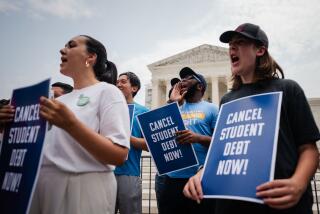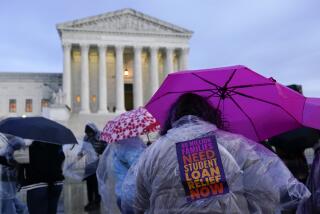Peru Delays Payments on Foreign Debt : Government Says It Will Also Determine Own Interest Rates
- Share via
LIMA, Peru — The government announced Saturday that it would delay for three more months its payments on foreign debt principal and would set its own interest rates on the payments, replacing those set by the lending banks.
Central Reserve Bank spokesmen said the action applies to virtually all of Peru’s creditors, with the exception of international lending agencies.
A decree published in the official newspaper El Peruano extended until May 2 the moratorium initially imposed by President Alan Garcia’s center-left government on Aug. 1. During the moratorium, Peru has been paying interest to the international agencies but nothing to its bank creditors.
The announcement that Peru would set its own lower interest rates is expected to further strain relations with the nation’s foreign creditors. Figures for the current interest rates on the various loans were not available Saturday.
Garcia shocked the banking community when he announced in his inaugural address July 28 that he would limit payments on Peru’s $13.7-billion foreign debt to 10% of the country’s export earnings. His action raised fears that other countries with much larger debts would follow his lead.
The government initially estimated that its export earnings for the year would be $3 billion.
Sources at the Central Reserve Bank said the government paid $191 million in interest on its debt to foreign lending agencies from August to December, keeping up with the 10% ceiling. The government has said it is making payments to the agencies in hopes of receiving fresh credit from them.
No Meetings With Creditors
The initial delay was on principal payments, and nothing was paid on Peru’s debt to foreign banks.
Garcia’s representatives have yet to meet with foreign creditors. Economy Minister Luis Alva Castro had said in August that the administration wanted to postpone any talks with foreign creditors for six months. He said it hoped it then would have its economic program in place and would be able to negotiate payments from a position of strength.
Richard Webb, the former president of the Central Reserve Bank, held informal meetings with New York bankers in January, but no concrete agreements were announced and the bankers complained of a lack of progress.
In October, the United States downgraded Peru’s debt status to “value-impaired,” reducing the country’s already limited credit line to commercial banks.
The extension of the debt-payment moratorium came as the government announced that inflation had increased to 5.2% in January from 2.8% in December.
Garcia, in a move to slow inflation that had threatened to reach 300% annually, imposed austerity measures that included devaluating the currency, price controls, raising the price of gasoline and freezing the wages of government employees.
The government has recently been forced to import large quantities of meat, potatoes and other foods in order to ease severe shortages that the Chamber of Commerce blames on the price controls installed in August.
An editorial published last Monday in the chamber’s weekly bulletin said the food shortages and subsequent imports “not only affect the balance of payments . . . but also increase budget imbalances, reactivate inflationary pressures, increase the dependence on foreign countries and generally darken the perspectives of the national economy.”
More to Read
Sign up for Essential California
The most important California stories and recommendations in your inbox every morning.
You may occasionally receive promotional content from the Los Angeles Times.










